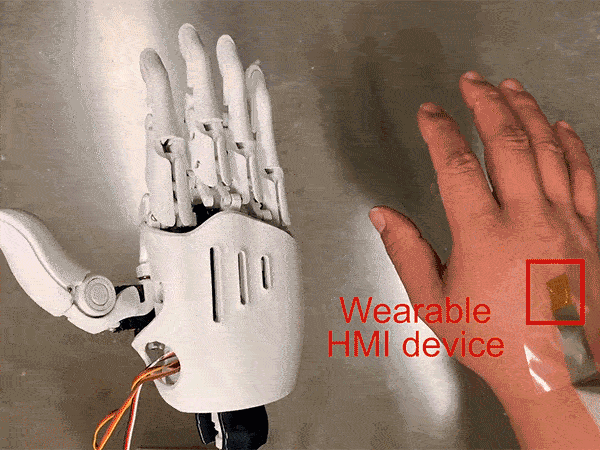Engineers at the University of Houston are trying to make the melding of humans and machines a little easier on the humans. They’ve developed an easy-to-manufacture flexible electronics patch that, when attached to a human, translates the person’s motion and other commands to a robot and receives temperature feedback from the robot.
Led by University of Houston assistant professor Cunjiang Yu, the team developed transistors, RRAM memory cells, strain sensors, UV-light detectors, temperature sensors, and heaters all using the same set of materials in a low-temperature manufacturing process. They integrated the different devices into a 4-micrometer-thick adhesive plastic patch.
A paper describing the Houston researchers’ work appears this week in Science Advances.
With the patch on the back of a volunteer’s hand, the researchers were able to control a robot hand—causing it to close or open according to what the human’s hand motion did to the patch’s strain sensors. What’s more, they were able to close the human-robot control loop by providing temperature feedback from the robotic hand to the human one using the patch’s integrated heater circuits.

The devices are all structures patterned using photolithography and are made up of 50-nanometer-thick gold conductors, indium zinc oxide (IZO) semiconductor, polyimide encapsulation, and (for the transistors) a common dielectric epoxy called SU-8. The conductors’ serpentine shape allows the devices to stretch with the polymide without breaking, but it’s the semiconductor’s versatility that is the real star of the show.
IZO acts as an electron-conducting semiconductor in the transistors and a photoconductor in the UV sensors. IZO’s resistance decreases with temperature, so it could act as a variable resistor in the temperature sensor (thermistor); its resistance increases with strain, so it can form a strain sensor. And in yet another structural arrangement of these materials, certain voltages will form or break conductive filaments in the IZO, yielding nonvolatile resistive memory (RRAM). The IZO maintains all this functionality even after being deposited as a colloid and drying to form a gel, a so-called sol-gel process.
“It’s quite astonishing,” says Yu. “Traditionally, to achieve multiple functions you might need the heterogeneous integration of materials, or multiple chips together. But now using one material you can do all this.”
Samuel K. Moore is the senior editor at IEEE Spectrum in charge of semiconductors coverage. An IEEE member, he has a bachelor's degree in biomedical engineering from Brown University and a master's degree in journalism from New York University.



